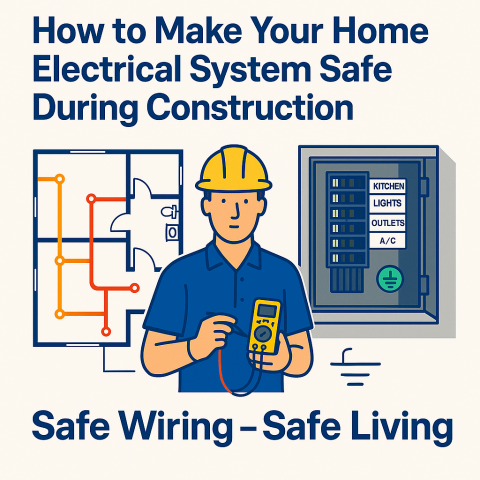How to Make Your Home Electrical System Safe During Construction
Safe Electrical System for Your Home: What to Consider During Construction
A practical and engineering-based guide for homeowners building in tropical regions
Why Electrical Safety Is Non-Negotiable
When building a house, especially in countries like the Philippines with high humidity, strong rains, and unstable public grids, a safe and well-planned electrical system is essential. Poor design or installation can lead to:
Fire hazards
Short circuits
Equipment failure
Dangerous electric shocks
Premature cable degradation
1. Use a Licensed Electrical Engineer or Electrician
Never let general workers or "handymen" install your wiring.
Ensure you hire:
A PRC-licensed electrical engineer for system planning and load calculation
A licensed electrician for actual installation
Both should follow the Philippine Electrical Code (PEC) or international standards (IEC)
2. Plan Load and Circuit Distribution Carefully
Your house must have:
A clear load schedule (how many amps per room, per appliance)
Dedicated circuits for high-load equipment (air conditioners, heaters, ovens, pumps)
Separate lines for lighting, outlets, and kitchen loads
This avoids overloading and enables easy troubleshooting later.
Example:
2.0 HP aircon → separate 20–30 A breaker
Microwave, oven → own circuit
Bedrooms → 10–15 A each
3. Use the Right Materials
Wires:
Use copper, not aluminum
Minimum wire size for outlets: 2.0 mm²
For aircon/heavy loads: 3.5–5.5 mm²
Use heat and moisture-resistant cables (e.g. THHN or TW types)
Breakers:
Only use known brands: Schneider, ABB, Panasonic, Siemens
Avoid "no-name" breakers from cheap hardware stores
Main breaker must match total load + 25–30% margin
Panel Board:
Proper enclosure (metal, earthed)
Accessible but protected location
Labels for all circuits
4. Install a Proper Grounding System
A safe grounding system prevents shock and protects your equipment.
Use ground rods at least 2.4 meters long
Ground the main panel, appliance chassis, and metal fixtures
Bond all grounds together (equipotential bonding)
Use green wires for grounding, color-coded by standard.
5. Include RCD (Residual Current Device) / ELCB Protection
Install RCDs or RCCBs to cut off power in case of leakage current (e.g. water + electricity = fatal risk).
30 mA trip sensitivity
Install per room or per sensitive area (bathroom, outdoor, kitchen)
Combine with MCBs in your panel
This is a life-saving component, not optional.
6. Avoid Common Installation Mistakes
Running wires directly in cement without conduit
No junction boxes or open splices
Loose or unlabelled breakers
Undersized wires or cheap breakers
Exposed cables in damp areas
Always install all wires in conduit (PVC or flexible) – underground and surface.
7. Integrate Solar and Backup Systems Safely
If you plan to use:
Solar power: Install with hybrid inverter, proper disconnects, and surge protection
Generator: Use a transfer switch to avoid backfeeding the grid
Battery system: Needs proper ventilation, fuse protection, and fireproof placement
These must be planned before finalizing your panel board layout.
8. Final Checklist Before Commissioning
Before energizing your house:
Ground test: <5 ohms preferred
Insulation resistance test for wiring
Load test of main breakers
Circuit labeling completed
All outlets polarity-checked
Lighting and switch operation tested
Conclusion: Safe Wiring = Safe Living
Electrical work is not a place to cut corners.
With high humidity, unpredictable voltage, and sensitive equipment (like ACs or smart devices), every connection counts.
By following correct standards, hiring professionals, and using quality materials, your home will be:
Safer
More efficient
Easier to expand later
And compliant with insurance or utility inspection
Build it right. Power it safe.
Autor: Nils Deden


Comments
There are no comments yet